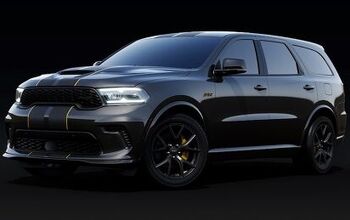Sales Recovery Survey: False Dawn?
The question of a sales recovery looms large in discussions of GM and Chrysler’s road to viability. In particular, GM has been accused of overestimating demand recovery, as its successive viability plans have consistently revised demand assumptions downwards. But a survey and followup by RL Polk ( full report in PDF) suggests that not only are a significant number of American consumers considering vehicle purchases, but many would buy American to “support the economy.” In all of the surveyed regions at least 50 percent of vehicle owners aged 18-64 said they planned a vehicle purchase in the next two years. Good news for Detroit? Polk’s breathless press release for updated regional data sure makes it sound like it. “In fact, more than a quarter of consumers we talked to as of the end of March plan to buy a new car or truck within the next year, even better news for automakers struggling to move excess inventory from dealer showrooms,” says Polk’s Lonnie Miller. But a closer look at the original survey shows that it’s too early to start counting chickens.
The study shows that 60 percent of consumers oppose the auto bailouts, despite acknowledging that bankruptcies would be “a major blow” to the US economy. But the data also shows Americans taking a pragmatic approach to the alleged crisis. Though predictions about the state of the economy over the next twelve months were all over the place, over half of respondents predict that their family’s financial status would stay the same. Less than 30 percent predicted their situation worsening. Still, 32 percent predicted a vehicle purchase in the next year, while 26 percent were considering a purchase in the next two years. 72 percent would “consider” a domestic vehicle in order to “support the American economy.” Tragically no control was done to show, for example, how many respondents would be willing to take a sharp stick in the eye “to support the American economy.”
Besides, the key metrics in the survey show that the average length of vehicle ownership is increasing, and that as many Americans are considering used vehicles as domestics. Average ownership length for new cars is now 56.3 months, up about six months since 2002 and on a long-term trend upwards. Two thirds of respondents tell Polk that they are “very likely” or “extremely likely” to keep vehicles “longer than they would otherwise,” with another 25 percent responding “somewhat likely.” Worse still for Detroit is the 70 percent reporting being at least “somewhat likely” to consider a used vehicle.
Polk’s picture is clear: the economy is bad so people are holding onto their vehicles longer and considering used cars. The common sense of these conclusions stand in sharp contrast to the “would you buy a Detroit-made car to feed your family” question. Re-parsed through a regional lense the data comes out looking better from Detroit, but the underlying trends clearly point to a persistently weak market for new cars.
More by Edward Niedermeyer
Latest Car Reviews
Read moreLatest Product Reviews
Read moreRecent Comments
- Dr.Nick What about Infiniti? Some of those cars might be interesting, whereas not much at Nissan interest me other than the Z which is probably big bucks.
- Dave Holzman My '08 Civic (stick, 159k on the clock) is my favorite car that I've ever owned. If I had to choose between the current Civic and Corolla, I'd test drive 'em (with stick), and see how they felt. But I'd be approaching this choice partial to the Civic. I would not want any sort of automatic transmission, or the turbo engine.
- Merc190 I would say Civic Si all the way if it still revved to 8300 rpm with no turbo. But nowadays I would pick the Corolla because I think they have a more clear idea on their respective models identity and mission. I also believe Toyota has a higher standard for quality.
- Dave Holzman I think we're mixing up a few things here. I won't swear to it, but I'd be damned surprised if they were putting fire retardant in the seats of any cars from the '50s, or even the '60s. I can't quite conjure up the new car smell of the '57 Chevy my parents bought on October 17th of that year... but I could do so--vividly--until the last five years or so. I loved that scent, and when I smelled it, I could see the snow on Hollis Street in Cambridge Mass, as one or the other parent got ready to drive me to nursery school, and I could remember staring up at the sky on Christmas Eve, 1957, wondering if I might see Santa Claus flying overhead in his sleigh. No, I don't think the fire retardant on the foam in the seats of 21st (and maybe late 20th) century cars has anything to do with new car smell. (That doesn't mean new car small lacked toxicity--it probably had some.)
- ToolGuy Is this a website or a podcast with homework? You want me to answer the QOTD before I listen to the podcast? Last time I worked on one of our vehicles (2010 RAV4 2.5L L4) was this past week -- replaced the right front passenger window regulator (only problem turned out to be two loose screws, but went ahead and installed the new part), replaced a bulb in the dash, finally ordered new upper dash finishers (non-OEM) because I cracked one of them ~2 years ago.Looked at the mileage (157K) and scratched my head and proactively ordered plugs, coils, PCV valve, air filter and a spare oil filter, plus a new oil filter housing (for the weirdo cartridge-type filter). Those might go in tomorrow. Is this interesting to you? It ain't that interesting to me. 😉The more intriguing part to me, is I have noticed some 'blowby' (but is it) when the oil filler cap is removed which I don't think was there before. But of course I'm old and forgetful. Is it worth doing a compression test? Leakdown test? Perhaps if a guy were already replacing the plugs...


































Comments
Join the conversation
After taking a brief look at the Polk study, the only conclusion is that it's garbage. They conveniently forget to state any relevant sample characteristics, which would allow you to judge its quality, and from my experience of dealing with market research, 713 is not nearly enough for any sort of reliable conclusions. Add to that the fact that questions are generally interpreted as answered by most market research agencies, without checks for consistency. It's not necessarily malicious but the problem is that the majority of the people doing these interpretations really do not have the necessary statistical grounding, intellectual curiosity and honesty, or in most cases money (for a properly designed, sufficient sample size study) to produce anything meaningful. In all market research I've seen or been involved in, intention is a very weak predictor and usually reflects a post purchase rationalisation bias. People are generally consistent, so as a theoretical example, someone who states they have a preference for Ford will most likely have a high intention of their next purchased vehicle being a Ford. Wheone looks at actual purchase behaviour for that individual, brand loyalty rates tend to be no higher than for people, who express no preference for a brand and a much lower intention of purchasing the same brand.